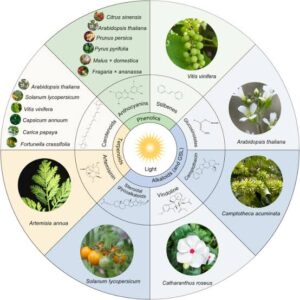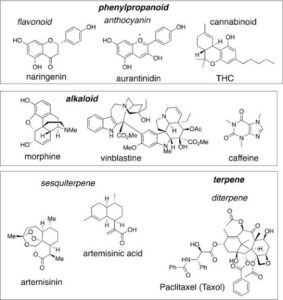Back to: Botany 200 Level
Hello, dear learner! I hope you’re having a great day! Have you ever noticed how some plants have a strong smell, bright colours, or even medicinal properties? Think about the bitterness of bitterleaf, the relaxing scent of eucalyptus, or the vibrant red of hibiscus flowers. These special characteristics come from compounds called alkaloids, flavonoids, terpenoids, and phenolics—all types of secondary metabolites.
Today, we’ll break down what these compounds are, how they help plants, and why they are important for humans.
Alkaloids, flavonoids, terpenoids, and phenolics
What Are Secondary Metabolites?
Unlike primary metabolites (which help plants grow and survive), secondary metabolites help plants adapt to their environment. They:

Protect plants from insects and herbivores.
Attract pollinators with colours and scents.
Have medicinal and nutritional value for humans.
The four major types of secondary metabolites are:
Alkaloids
Flavonoids
Terpenoids
Phenolics
Let’s take a closer look at each one!
1. Alkaloids – The Bitter Defenders
Alkaloids are nitrogen-containing compounds that often taste bitter. They help protect plants from being eaten by herbivores. Many alkaloids are also used in medicine because of their effects on the human nervous system.
Examples of Alkaloids
Caffeine (in coffee & tea) – Keeps you awake by stimulating the brain.
Quinine (in cinchona bark) – Used to treat malaria.
Morphine (from the opium poppy) – A powerful painkiller.
Nicotine (in tobacco) – A stimulant and insect repellent.
Example from Everyday Life:
When you drink bitterleaf soup, the bitterness comes from alkaloids, which help the plant protect itself but also have medicinal benefits for humans!
2. Flavonoids – The Colourful Protectors
Flavonoids are responsible for the bright colours in flowers, fruits, and leaves. They help attract pollinators like bees and also act as antioxidants, protecting plants (and humans!) from damage.
Examples of Flavonoids
Anthocyanins – Give red, blue, and purple colours to hibiscus, grapes, and berries.
Quercetin – Found in onions and apples, helps with immunity.
Catechins – Found in green tea, known for health benefits.
Example from Everyday Life:
The red colour in zobo drink (hibiscus tea) comes from flavonoids, which also act as antioxidants to keep you healthy!
3. Terpenoids – The Fragrant Warriors
Terpenoids are responsible for the strong smells of plants. They help repel insects and attract pollinators. Many terpenoids are used in essential oils, perfumes, and medicines.
Examples of Terpenoids
Menthol (in mint leaves) – Used in balms for a cooling effect.
Limonene (in citrus fruits) – Gives oranges and lemons their fresh scent.
Eucalyptol (in eucalyptus) – Used to treat coughs and colds.
Taxol (from yew trees) – Used in cancer treatment.
Example from Everyday Life:
When you rub scent leaves (nchuanwu) between your fingers, the strong smell comes from terpenoids that help the plant repel insects!

4. Phenolics – The Natural Protectors
Phenolics help protect plants from infections, UV radiation, and stress. They also have antioxidant properties that help keep humans healthy.
Examples of Phenolics
Tannins (in tea & unripe fruits) – Give a dry, bitter taste.
Resveratrol (in grapes & wine) – Helps prevent heart disease.
Lignin (in wood & bark) – Provides strength to plants.
Example from Everyday Life:
The dry, slightly bitter taste of over-steeped tea comes from tannins, which help protect the plant from predators!
Why Are These Compounds Important?
They help plants survive – by repelling predators, attracting pollinators, and adapting to stress.
They benefit humans – in medicine, food, cosmetics, and industry.
They have antioxidant properties – helping prevent diseases like cancer and heart disease.
Summary
Alkaloids are bitter compounds used for defence and medicine (e.g., caffeine, morphine).
Flavonoids give plants their colours and have antioxidant benefits (e.g., anthocyanins in hibiscus).
Terpenoids are responsible for plant scents and essential oils (e.g., menthol in mint).
Phenolics protect plants from infections and act as antioxidants (e.g., tannins in tea).
Let’s Test Your Understanding:
- Why do alkaloids usually taste bitter?
- Which secondary metabolite is responsible for plant fragrance?
- Give an example of a flavonoid and its function.
Fantastic work, superstar! Now you know why plants smell, taste, and look the way they do. Keep learning, and see you in
the next lesson!
